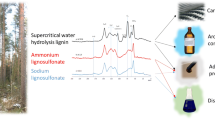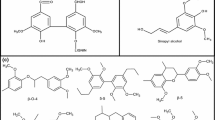Abstract
The structural characteristics of the lignin from potassium hydroxide (KOH) liquor of jute stick (Corchorus capsularis) pulping were determined and compared with the isolated dioxane lignin from jute stick. The lignin structure was characterized by elemental, methoxyl group analysis, UV, FTIR, 1H-NMR, 31P-NMR, and 2D-NMR spectroscopy and molecular weight. 2D-NMR of both lignins isolated showed a predominance of β-O-4 aryl ether linkages. KOH pulping cleaved β-O-4 aryl ether linkage and increased phenolic hydroxyl group and reduced molecular weight. KOH lignin can replace 40% phenol in phenol-formaldehyde resin with satisfactory shear strength.






Similar content being viewed by others
References
Hammett AL, Youngs RL, Sun X, Chandra M (2001) Non-wood fiber as an alternative to wood fiber in Chinas pulp and paper industry. Holzforschung 55(2):219–224
Jahan MS, Akter T, Nayeem J, Samaddar PR, Moniruzzaman M (2016b) Potassium hydroxide pulping of saccharumspontaneum (kash). J-FOR-Journal of Science & Technology for Forest Products and Processes 6(1):46–53
Jahan MS, Haris F, Rahman MM, Samaddar PR, Sutradhar S (2016a) Potassium hydroxide pulping of rice straw in biorefinery initiatives. Bioresour Technol 219:445–450
FAO (2020) http://www.fao.org/faostat/en/#data/QC. Accessed 1 Aug 2020
Xu F, Sun JX, Sun R, Fowler P, Baird MS (2006) Comparative study of organosolv lignins from wheat straw. Industrial Crops and Products 23(2):180–193
Huang GL, Shi JX, Langrish TA (2008) Environmentally friendly bagasse pulping with NH4 OH–KOH–AQ. Journal of Cleaner Production 16(12):1287–1293
Huang G, Shi JX Langrish TA (2007) A new pulping process for wheat straw to reduce problems with the discharge of black liquor. Bioresource Technology 98(15):2829–2835
Popy RS, Ni Y, Salam A, Jahan MS (2020) Mild potassium hydroxide-based alkaline integrated biorefinery process of Kash (Saccharum spontaneum). Ind Crop Prod 154:112738. https://doi.org/10.1016/j.indcrop.2020.112738
Sutradhar S, Sarkar M, Nayeem J, Jahan MS, Tian C (2018) Potassium hydroxide pulping of four non-woods. Bangladesh Journal of Scientific and Industrial Research 53(1):1–6
van Heiningen A (2006) Converting a kraft pulp mill into an integrated forest biorefinery. Pulp & Paper Canada 107(6):38–43
Cherubini F (2010) The biorefinery concept: using biomass instead of oil for producing energy and chemicals. Energy Conversion and Management 51(7):1412–1421
Dutta S, Kim J, Ide Y, Kim JH, Hossain MSA, Bando Y, Yamauchi Y et al (2017) Cellulose-based energy devices. Materials Horizons 4:522–545. https://doi.org/10.1039/C7MH90017A
Ragauskas AJ, Williams CK, Davison BH, Britovsek G, Cairney J, Eckert CA, Mielenz JR (2006) The path forward for biofuels and biomaterials. Science 311(5760):484–489
Sutradhar S, Arafat KMY, Nayeem J, Jahan MS (2020) Organic acid lignin from rice straw in phenol-formaldehyde resin preparation for plywood. Cellul Chem Technol 54(5-6):463–471
Popy RS, Nayeem J, Arafat KMY, Rahman MM, Jahan MS (2020) Mild potassium hydroxide pulping of straw. Current Research in Green and Sustainable Chemistry 3:100015
Thomsen AM (1953) Method of making a lignin fertilizer base. U.S. Patent No. 2,663,628. U.S. Patent and Trademark Office, Washington, DC
Aro T, Fatehi P (2017) Production and application of lignosulfonates and sulfonated lignin. ChemSusChem 10(9):1861–1877
García MC, Diez JA, Vallejo A, Garcia L, Cartagena MC (1996) Use of kraft pine lignin in controlled-release fertilizer formulations. Ind Eng Chem Res 35(1):245–249
Gellerstedt G, Tomani P, Axegård P, Backlund B (2013) Lignin recovery and lignin-based products. In: Integrated forest biorefineries–challenges and opportunities. Royal Society of Chemisty, Cambridge, pp 180–210
Abejón R, Rabadán J, Garea A, Irabien A (2020) Comparison of supported ionic liquid membranes and polymeric ultrafiltration and nanofiltration membranes for separation of lignin and monosaccharides. Membranes 10(2):29
Tomani P (2010) The lignoboost process. Cellul Chem Technol 44:53–58
Ma X, Yang X, Zheng X, Chen L, Huang L, Cao S, Akinosho H (2015) Toward a further understanding of hydrothermally pretreated holocellulose and isolated pseudo lignin. Cellulose 22(3):1687–1696
Ma X, Zheng X, Yang H, Wu H, Cao S, Chen L, Huang L (2016) A perspective on lignin effects on hemicelluloses dissolution for bamboo pretreatment. Ind Crop Prod 94:117–121
Zhang N, Li Z, Xiao Y, Pan Z, Jia P, Feng G, Bao C, Zhou Y, Hua L (2020) Lignin-based phenolic resin modified with whisker silicon and its application. Journal of Bioresources and Bioproducts 5(1):67–77
Liao YT, Matsagar BM, Wu KCW (2018) Metal–organic framework (MOF)-derived effective solid catalysts for valorization of lignocellulosic biomass. ACS Sustain Chem Eng 6(11):13628–13643
Saeed A, Jahan MS, Li H, Liu Z, Ni Y, van Heiningen A (2012) Mass balances of components dissolved in the pre-hydrolysis liquor of kraft-based dissolving pulp production process from Canadian hardwoods. Biomass Bioenergy 39:14–19. https://doi.org/10.1016/j.biombioe.2010.08.039
Rinaldi R, Jastrzebski R, Clough MT, Ralph J, Kennema M, Bruijnincx PC, Weckhuysen BM (2016) Paving the way for lignin valorisation: recent advances in bioengineering, biorefining and catalysis. Angew Chem Int Ed 55(29):8164–8215
Hu L, Pan H, Zhou Y, Zhang M (2011) Methods to improve lignin’s reactivity as a phenol substitute and as replacement for other phenolic compounds: A brief review. BioResources 6(3):3515–3525
Ge Y, Li Z (2018) Application of lignin and its derivatives in adsorption of heavy metal ions in water: a review. ACS Sustain Chem Eng 6(5):7181–7192
Huang Y, Duan Y, Qiu S, Wang M, Ju C, Cao H, Fang Y et al (2018) Lignin-first biorefinery: a reusable catalyst for lignin depolymerization and application of lignin oil to jet fuel aromatics and polyurethane feedstock. Sustain Energy Fuels 2(3):637–647. https://doi.org/10.1039/C7SE00535K
Thielemans W, Can E, Morye SS, Wool RP (2002) Novel applications of lignin in composite materials. J Appl Polym Sci 83(2):323–331
Kazzaz AE, Fatehi P (2020) Technical lignin and its potential modification routes: a mini-review. Ind Crop Prod 154:112732
Vishtal AG, Kraslawski A (2011) Challenges in industrial applications of technical lignins. Bioresources 6(3):3547–3568
Yang S, Wu JQ, Zhang Y, Yuan TQ, Sun RC (2015) Preparation of lignin-phenol-formaldehyde resin adhesive based on active sites of technical lignin. Journal of Biobased Materials and Bioenergy 9(2):266–272
Poppius-Levlin K, Hortling B, Sundquist J (1993) Milox pulping and bleaching. Possibilies to avoid chlorine chemicals. In: Proceedings of “International Symposium on Wood and Pulping Chemistry”, Beijing, People’s Republic of China, May 25–28, 1993, pp 214–222
Pan XJ, Sano Y (1999) Atmospheric acetic acid pulping of rice Straw IV: physicochemical characterization of acetic acid lignins from rice straw and woods. Part 2. Chemical Structures. Holzforschung 53:590–596
Zhao X, Liu D (2010) Chemical and thermal characteristics of lignins isolated from Siam weed stem by acetic acid and formic acid delignification. Ind Crop Prod 32(3):284–291
Fergus BJ, Goring DAI (1970) The location of guaiacyl and syringyl lignins in birch xylem tissue. Holzforschung 24(4):113–117
Higuchi T, Ito Y, Kawamura I (1967) p-Hydroxyphenylpropane component of grass lignin and role of tyrosine-ammonia lyase in its formation. Phytochemistry 6:875–881
Sakakibara A (1991) Chemistry of lignin. In: Hon DN-S, Shiraishi N (eds) Wood and cellulosic chemistry. Marcel Dekker, New York, pp 113–175
Islam A, Sarkanen KV (1993) The isolation and characterization of the lignins of jute (Corchorus capsularis). Holzforschung 47:123–132
JAHAN MS, Mun SP (2006) Characteristics of milled wood lignins isolated from different ages of nalita wood (Trema orientalis). Cellul Chem Technol 40(6):457–467
Faix O (1991) Classification of lignins from different botanical origins by FTIR spectroscopy. Holzforschung 45(Suppl):21–27
Faix O (1992) Fourier transform infrared spectroscopy. In: Lin SY, Dence CW (eds) Methods in lignin chemistry. Springer-Verlag, Berlin, pp 83–109
Sarkanen KV, Chang HM, Allan GG (1967a) Species variation in lignins. 3. Hardwood lignins. Tappi 50(12):587
Sarkanen KV, Chang H-M, Allan GG (1967b) Species variation in lignins. 2. Conifer lignins. Tappi J 50:583–586
Huang C, He J, Narron R, Wang Y, Yong Q (2017) Characterization of kraft lignin fractions obtained by sequential ultrafiltration and their potential application as a biobased component in blends with polyethylene. ACS Sustain Chem Eng 5:11770–11779. https://doi.org/10.1021/acssuschemeng.7b03415
Yoo CG, Li M, Meng X, Pu Y, Ragauskas AJ (2017) Effects of organosolv and ammonia pretreatments on lignin properties and its inhibition for enzymatic hydrolysis. Green Chem 19:2006–2016. https://doi.org/10.1039/c6gc03627a
Domínguez-Robles J, Sánchez R, Díaz-Carrasco P, Espinosa E, García-Domínguez MT, Rodríguez A (2017) Isolation and characterization of lignins from wheat straw: application as binder in lithium batteries. Int J Biol Macromol 104:909–918. https://doi.org/10.1016/j.ijbiomac.2017.07.015
Rossberg C, Janzon R, Saake B, Leschinsky M (2019) Effect of process parameters in pilot scale operation on properties of organosolv lignin. Bio Resources 14:4543–4559. https://doi.org/10.15376/biores.14.2.4543-4559
Ibrahim MNM, Zakaria N, Sipaut CS, Sulaiman O, Hashim R (2011) Chemical and thermal properties of lignins from oil palm biomass as a substitute for phenol in a phenol formaldehyde resin production. Carbohydr Polym 86(1):112–119
Del Rio JC, Rencoret J, Marques G, Li J, Gellerstedt G, Jimenez-Barbero J et al (2009) Structural characterization of the lignin from jute (Corchorus capsularis) fibers. J Agric Food Chem 57(21):10271–10281. https://doi.org/10.1021/jf900815x
Gong X, Liu T, Yu S, Meng Y, Lu J, Cheng Y, Wang H (2020) The preparation and performance of a novel lignin-based adhesive without formaldehyde. Ind Crop Prod 153:112593
Luo B, Jia Z, Jiang H, Wang S, Min D (2020) Improving the reactivity of sugarcane bagasse Kraft lignin by a combination of fractionation and phenolation for phenol–formaldehyde adhesive applications. Polymers 12(8):1825
Younesi-Kordkheili H, Pizzi A (2020) Improving the properties of urea-lignin-glyoxal resin as a wood adhesive by small addition of epoxy. Int J Adhes Adhes 102:102681. https://doi.org/10.1016/j.ijadhadh.2020.102681
Ghaffar SH, Fan M (2014) Lignin in straw and its applications as an adhesive. Int J Adhes Adhes 48:92–101. https://doi.org/10.1016/j.ijadhadh.2013.09.001
Pang B, Yang S, Fang W, Yuan TQ, Argyropoulos DS, Sun RC (2017) Structure-property relationships for technical lignins for the production of lignin-phenol-formaldehyde resins. Ind Crop Prod 108:316–326. https://doi.org/10.1016/j.indcrop.2017.07.009
Jablonskis A, Arshanitsa A, Arnautov A, Telysheva G, Evtuguin D (2018) Evaluation of Ligno Boost™ softwood kraft lignin epoxidation as an approach for its application in cured epoxy resins. Ind Crop Prod 112:225–235
Author information
Authors and Affiliations
Corresponding author
Additional information
Publisher’s note
Springer Nature remains neutral with regard to jurisdictional claims in published maps and institutional affiliations.
Rights and permissions
About this article
Cite this article
Rahman, M.M., Arafat, K.M.Y., Jin, Y. et al. Structural characterization of potassium hydroxide liquor lignin and its application in biorefinery. Biomass Conv. Bioref. 13, 727–737 (2023). https://doi.org/10.1007/s13399-020-01202-1
Received:
Revised:
Accepted:
Published:
Issue Date:
DOI: https://doi.org/10.1007/s13399-020-01202-1




